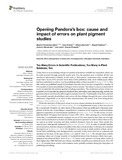Mostrar el registro sencillo del ítem
Opening Pandora's box: cause and impact of errors on plant pigment studies
| dc.creator | Fernández Marín, Beatriz | es_ES |
| dc.creator | Artetxe, Unai | es_ES |
| dc.creator | Barrutia, Oihana | es_ES |
| dc.creator | Esteban Terradillos, Raquel | es_ES |
| dc.creator | Hernández, Antonio | es_ES |
| dc.creator | García Plazaola, José Ignacio | es_ES |
| dc.date.accessioned | 2018-09-04T06:43:51Z | |
| dc.date.available | 2018-09-04T06:43:51Z | |
| dc.date.issued | 2015 | |
| dc.identifier.issn | 1664-462X (Electronic) | |
| dc.identifier.uri | https://hdl.handle.net/2454/30441 | |
| dc.description.abstract | Today, there is an astonishing volume of scientific information available for researchers, which can be easily accessed through powerful search tools. Yet, the question now is whether all this vast amount of information is reliable. In this sense, a “bad science” controversy arose recently when many Open Access (OA) journals (more than a half) published a false, error-ridden paper, which had been submitted in order to test the publishing ethics of these journals (Bohannon, 2013). This fake article was published mainly by fraudulent journals, but it was also accepted by a number of OA journals of renowned publishers with peer-review systems. The failure to reject an article full of errors revealed that the system's gearbox is leaking somewhere. The carelessness of peer-reviews in a number of OA journals has opened a Pandora's Box, and what is more disconcerting, nobody can guarantee that it could not also affect regular journals (non OA). Traditionally, it has been assumed that scientific journals should detect and correct all these failings through the peer review before publication. Regrettably, as we show in this communication, the system is far from being perfect (Pulverer, 2010; Székely et al., 2014). | en |
| dc.description.sponsorship | Supporting from BFU 2010-15021, UPV/EHU-GV IT-624-13 grant, JAE-Doc-2011-046 fellow from the Spanish National Research Council (CSIC) received by RE and Marie Curie IEF grant (328370 MELISSA) from the European FP7-PEOPLE received by BF-M, are acknowledged. | en |
| dc.format.extent | 5 p. | |
| dc.format.mimetype | application/pdf | en |
| dc.format.mimetype | application/zip | en |
| dc.language.iso | eng | en |
| dc.publisher | Frontiers Media | en |
| dc.relation.ispartof | Frontiers in Plant Science, 6: 148 | en |
| dc.rights | © 2015 Fernández-Marín, Artetxe, Barrutia, Esteban, Hernández and García-Plazaola. This is an open-access article distributed under the terms of the Creative Commons Attribution License (CC BY). The use, distribution or reproduction in other forums is permitted, provided the original author(s) or licensor are credited and that the original publication in this journal is cited, in accordance with accepted academic practice. No use, distribution or reproduction is permitted which does not comply with these terms. | en |
| dc.rights.uri | https://creativecommons.org/licenses/by/4.0/ | |
| dc.subject | Plant pigment studies | en |
| dc.subject | Errors | en |
| dc.title | Opening Pandora's box: cause and impact of errors on plant pigment studies | en |
| dc.type | info:eu-repo/semantics/article | en |
| dc.type | Artículo / Artikulua | es |
| dc.contributor.department | IdAB. Instituto de Agrobiotecnología / Agrobioteknologiako Institutua | es |
| dc.rights.accessRights | info:eu-repo/semantics/openAccess | en |
| dc.rights.accessRights | Acceso abierto / Sarbide irekia | es |
| dc.identifier.doi | 10.3389/fpls.2015.00148 | |
| dc.relation.projectID | info:eu-repo/grantAgreement/European Commission/FP7/328370 | en |
| dc.relation.publisherversion | https://doi.org/10.3389/fpls.2015.00148 | |
| dc.type.version | info:eu-repo/semantics/publishedVersion | en |
| dc.type.version | Versión publicada / Argitaratu den bertsioa | es |
Ficheros en el ítem
Este ítem aparece en la(s) siguiente(s) colección(ones)
La licencia del ítem se describe como © 2015 Fernández-Marín, Artetxe, Barrutia, Esteban, Hernández and García-Plazaola. This is an open-access article distributed under the terms of the Creative Commons Attribution License (CC BY). The use, distribution or reproduction in other forums is permitted, provided the original author(s) or licensor are credited and that the original publication in this journal is cited, in accordance with accepted academic practice. No use, distribution or reproduction is permitted which does not comply with these terms.



